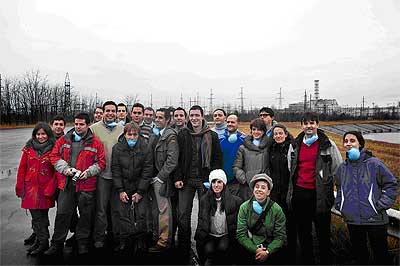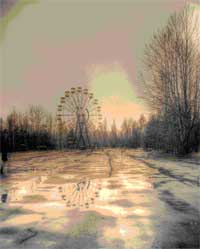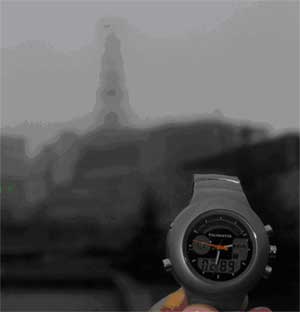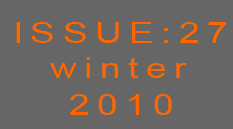

A visit to Chernobyl: Learning about what happened, where it happened.
Most people know that in April 1986 the world’s nuclear industry was shattered by the accident that occurred involving the N° 4 reactor at the Chernobyl Nuclear Power Plant (ChNPP) in Ukraine. Since then, every nuclear debate, every interview, every lecture that has taken place in a school or university has always included mention of Chernobyl. It was, therefore, obvious to us at the Spanish Young Generation Network (Jóvenes Nucleares, JJNN - a group of young nuclear professionals with a scientific background) that we needed to increase our awareness of what really happened, to speak on a sound factual basis about the accident and its consequences.
So, on November 20th, 24 JJNN members took part in a technical visit to the ChNPP. 
Spanish JJNN delegation close to Chernobyl reactors 5 & 6. Chernobyl reactors 3 & 4 in the background.
Having entered the 30 km exclusion zone, the Spanish Young Generation members were first brought to the Agency of Information, International Cooperation and Development (Chernobyl Interinform) located in the village of Chernobyl, around 15 kilometers from the plant. The agency belongs to the Ministry of Emergencies and Affairs relating to Population Protection from the Consequences of the Chernobyl catastrophe in Ukraine. In the building the guide provided the delegation with basic information about the accident and the areas that were affected by it.
Back in the bus that would bring the visitors to the nuclear power plant, it was possible to see, from one side of the road, the two unfinished cooling towers of Chernobyl 5 and 6, which were under construction when the accident took place. From the other side of the road could be observed the building devoted to the management of radioactive waste from decommissioning activities as well as the storage of 25.000 fuel elements.
When the delegation arrived at the plant, and after having gone through the required security controls, it was welcomed in the “mock-up room” by the Technical Director for Safety, Alexander Y. Novikov, and by the Technical Director for Operation, Sergey A. Kondratenko. The mock-up room contained three scale models: one of the entire nuclear power plant as it would have looked (with six operating units) had the accident not taken place, another one of a turbine building and the third one of a reactor cooling pump. Mr. Novikov, who was working there at the time of the accident, related the event. In front of the scale model of the turbine building, Mr. Kondratenko explained that reactor 2 was definitively shut down in 1991 due to a fire that broke out during an outage of the unit.
After this first general introduction to the functioning of the plant, the Technical Director brought the representatives of the Spanish Young Generation to the control room of reactor 1. In the control room the participants could observe the two instrumentation systems of the reactor core. The first one provided information about more than 1600 high-pressure valves. A specific colour code represented the different control rods. The second system enabled the analysis of the position of the different control rods using analogical indicators. Mr. Kondratenko explained that the plant worked on the basis of 12-hour shifts (8 to 8) with 4 operators and a head of section in each shift.
The second stop during the visit was the turbine hall. This building was different from the rest of turbine buildings that can be seen in other nuclear power plants around the world. Indeed, while in other plants each reactor can have its own turbine building or, at the most, two reactors share the same one, in Chernobyl, however, the turbine hall (a building of more than 500 meters long) housed the four reactors’ turbines.
Before going to the sarcophagus, the delegation paid a visit to Prypiat, the city which was built in 1970 to host the workers of the plant and their families. Between 45.000 and 50.000 people lived there. The city was evacuated more than 24 hours after the accident. The soviet authorities told the inhabitants that they had to take with them what they needed for only one week, as they were supposed to return to their homes a week later. They never did. Since 1986, the city has continuously been the victim of looting. |

The Prypiat wheel
|
Back at the plant the visitors arrived at the sarcophagus observation point, where reactor 4 can be seen. On this spot is also the monument that was built in memory of the people who helped to build the sarcophagus. The visit ended in the offices at the observation point, where a guide explained the actual state of unit 4. After the accident, a precarious and temporary structure, the so-called sarcophagus, was built in a hurry, without the time needed to develop a proper permanent design. This structure is just a kind of containment building to isolate the damaged reactor. The delegation was informed about the SIP (Shelter Implementation Plan), which has an estimated budget of around 1300 million US dollars, aiming at building a new structure covering and isolating the existing one. The project, once implemented, should enable the manipulation and further extraction of the radioactive materials still on site for further treatment and storage. The SIP, which has 5 main objectives, foresees the development of 22 different tasks which include, among others, mitigation of the risk of collapse and structural stabilization, dust and water management, fuel containing materials characterisation, etc.
During the walks around the perimeter of the plant and inside Prypiat, the effective dose equivalent was measured using a hand-dosimeter for estimating external exposure. The maximum readings were found in exposure situations where radionuclides were accumulated in the wild weeds (e.g. moss). However, in comparison with dose rate levels found in the city of Prypiat, it was observed that close to the moss levels were 10 times higher, and 100 times higher than those ones measured inside ChNNP.

Picture 3: hand-dosimeter at the sarcophagus observation point.
Today, there are still around 3,000 people working in the Chernobyl area - plus the security forces surrounding the radiating 30 kilometers off-limits zone.
In the long-term, Chernobyl will remain a painful reminder of how important is to maintain higher safety standards and the responsibility that this technology brings with it. For all nuclear power professionals, who must always be committed to do their utmost to prevent any unexpected situations and be ready and prepared to act appropriately in the event of unforeseen circumstances: “good enough is not good enough”.
Thanks go to:
Spanish Nuclear Society Board.
Professor Emeritus Mr. Agustín Alonso.
Excellency Ambassador (View) Mr. José Luis Roselló.
Excellency Ambassador (Kiev) Mr. José Rodriguez Moyano.
Excellency Ambassador (View) Mr. Vododymyr Yelchenko
Mr. Alexander Y. Novikov: Technical Director for Safety (ChNNP)
Mr. Sergey A. Kondratenko: Technical Director for Operation (ChNNP)
Jóvenes Nucleares
Spanish Young Generation Network
|

